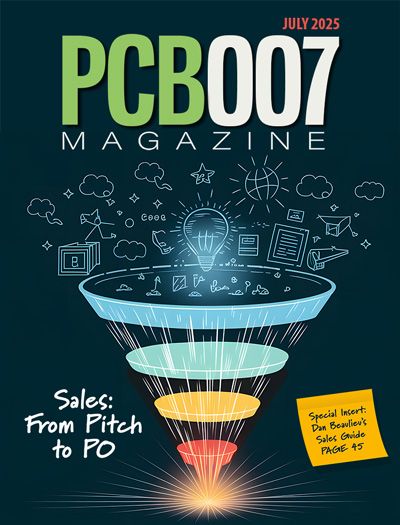-

- News
- Books
Featured Books
- pcb007 Magazine
Latest Issues
Current Issue
Advancing the Advanced Materials Discussion
Moore’s Law is no more, and the advanced material solutions to grapple with this reality are surprising, stunning, and perhaps a bit daunting. Buckle up for a dive into advanced materials and a glimpse into the next chapters of electronics manufacturing.

Inventing the Future With SEL
Two years after launching its state-of-the-art PCB facility, SEL shares lessons in vision, execution, and innovation, plus insights from industry icons and technology leaders shaping the future of PCB fabrication.

Sales: From Pitch to PO
From the first cold call to finally receiving that first purchase order, the July PCB007 Magazine breaks down some critical parts of the sales stack. To up your sales game, read on!
- Articles
- Columns
- Links
- Media kit
||| MENU - pcb007 Magazine
ENEPIG: The Plating Process
June 1, 2015 | George Milad, Uyemura International CorporationEstimated reading time: 1 minute
Electroless nickel/electroless palladium/immersion gold (ENEPIG) is sometimes referred to as the universal finish, because of the versatility of its applications. It is a multifunctional surface finish, applicable to soldering and wire bonding (gold, aluminum, copper and palladium clad copper). In addition, it is also suitable as the mating surface for soft membrane and steel dome contacts, low insertion force (LIF) and zero insertion force (ZIF) edge connectors, and for press-fit applications. ENEPIG is formed by the sequential deposition of electroless Ni (120–240 µin) followed by 2–12 µin of electroless Pd with an immersion gold flash (1–2 µin) on top.
Chemical Definitions
Electroless Process: This chemical process promotes sustained deposition of a metal or metal alloy onto the PWB surface through an oxidation-reduction chemical reaction, without the application of an external electrical potential. Reducing agents, such as sodium hypophosphite or sodium formate, react at catalytic surfaces to release electrons, which immediately reduce the positively charged metal ions (e.g., nickel ions in ENIG and ENEPIG and palladium ions in ENEPIG), promoting their deposition onto the PWB.
This type of reaction is described as autocatalytic, as the deposition process will continue even after the substrate is completely covered by a continuous layer of the plated deposit. The deposit thickness will therefore continue to rise in the presence of source metal ions and a reducing agent, until the board is removed from the plating bath. The thickness of plated deposits will vary depending on the bath temperature, chemical parameters (such as solution pH) and the amount of time spent in the plating bath.
Immersion Process: This chemical process uses a chemical displacement reaction to deposit a layer of a second metal onto a base metal surface. In this reaction, the base metal dissolves, releasing the electrons that reduce the positively charged ions of the second metal present in solution. Driven by the electrochemical potential difference, the metal ions in solution (e.g., gold ions in ENIG or ENEPIG process) are deposited onto the surface of the board, simultaneously displacing ions of the surface metal into solution.
Editor's Note: This article originally appeared in the May 2015 issue of The PCB Magazine.
Testimonial
"Advertising in PCB007 Magazine has been a great way to showcase our bare board testers to the right audience. The I-Connect007 team makes the process smooth and professional. We’re proud to be featured in such a trusted publication."
Klaus Koziol - atgSuggested Items
Nolan’s Notes: Tariffs, Technologies, and Optimization
10/01/2025 | Nolan Johnson -- Column: Nolan's NotesLast month, SMT007 Magazine spotlighted India, and boy, did we pick a good time to do so. Tariff and trade news involving India was breaking like a storm surge. The U.S. tariffs shifted India from one of the most favorable trade agreements to the least favorable. Electronics continue to be exempt for the time being, but lest you think that we’re free and clear because we manufacture electronics, steel and aluminum are specifically called out at the 50% tariff levels.
MacDermid Alpha & Graphic PLC Lead UK’s First Horizontal Electroless Copper Installation
09/30/2025 | MacDermid Alpha & Graphic PLCMacDermid Alpha Electronics Solutions, a leading supplier of integrated materials and chemistries to the electronics industry, is proud to support Graphic PLC, a Somacis company, with the installation of the first horizontal electroless copper metallization process in the UK.
Electrodeposited Copper Foils Market to Grow by $11.7 Billion Over 2025-2032
09/18/2025 | Globe NewswireThe global electrodeposited copper foils market is poised for dynamic growth, driven by the rising adoption in advanced electronics and renewable energy storage solutions.
MacDermid Alpha Showcases Advanced Interconnect Solutions at PCIM Asia 2025
09/18/2025 | MacDermid Alpha Electronics SolutionsMacDermid Alpha Electronic Solutions, a global leader in materials for power electronics and semiconductor assembly, will showcase its latest interconnect innovations in electronic interconnect materials at PCIM Asia 2025, held from September 24 to 26 at the Shanghai New International Expo Centre, Booth N5-E30
Trouble in Your Tank: Implementing Direct Metallization in Advanced Substrate Packaging
09/15/2025 | Michael Carano -- Column: Trouble in Your TankDirect metallization systems based on conductive graphite are gaining popularity throughout the world. The environmental and productivity gains achievable with this process are outstanding. Direct metallization reduces the costs of compliance, waste treatment, and legal issues related to chemical exposure. A graphite-based direct plate system has been devised to address these needs.


